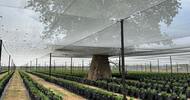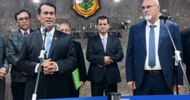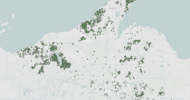By Marcos Fava Neves (Chinadaily.com.cn)
It is well known the need to increase food production, to face the incredible development of emerging markets and new consumers, and the scarce amount of land and natural resources available in the world to face this challenge.
In this story I want to comment on one of the most impressive ideas for regional development, showed at Harvard Seminar, as discussed by our last article on China Daily (26th of January). This is the case of Codevasf, a company owned by Brazilian Government, and dedicated to the development of the semi-arid Sao Francisco and Parnaiba River Valleys, at northeast of Brazil. This company came with a different concept of land occupation and regional development.
First, let me introduce our China Daily reader to these two Valleys. They have around 960.000 km2, an irrigated land potential of 360.000 ha, only in Sao Francisco Valley. In 2010, 120.000 ha are implemented by Codevasf, with 50% being used by 100 companies, mostly on fruit production and some processing (dried fruit, juices and wine). This area is responsible for US$ 300 million exports per year (40% of total Brazilian fresh fruit exports, and 100% of Brazilian mango and grapes export). It has around 2.800 hours of sunshine, what allows a year round crop production, with enough fresh water for irrigation and good transportation and connections. The average temperature is 25-30 Celsius, with a much defined rainfall. These specific conditions allow producers to take advantage of market windows for fruit exports.
Over 40 years, Codevasf built 28 irrigation projects. In the past, Codevasf purchased the non improved land, built infrastructure (roads, energy, administration) and irrigation system (canals and pumps), divided land in areas from 5 to 200 ha lots for investors, attracted farmers, made water and energy available. Codevasf also charged fees based on lot size, fees to cover operation and maintenance and the producer paid energy fees to the energy supplier. After the land was occupied, project was ready, than Codevasf transferred responsibility of operation and maintenance to an association of producers, named District.
Why this old model failed, bringing more than 50% of idle land? Mostly because it was production driven, and not market oriented or demand driven. Problems of lack of marketing, excess of production, low prices, lack of coordination, lack of innovation, products only directed for local consumption, subsistence farming in some producers, opportunistic intermediaries paying low prices to farmers, lack of scale, bad selection of producers, complicated proprietary issues. As a consequence… no taxes, no payments, no economic development and no return for all the investment done by Government in the region.
In 2010, after 5 years working together with World Bank and University of Sao Paulo, Codevasf is proposing a new concept. This concept already has an invitation to bid approved, and the auction will be in 2010 (for more information, see www.pontal.org). Brazilian Government wants a consortium company (can be an engineering company plus a food processor) that will occupy the area. This consortium will receive the land for free, and has to, within 6 years, finish constructing the common irrigation infrastructure (U$ 50 million, which will be reimbursed by Government), has 6 years to establish agricultural operations in all 8.000 ha, will be responsible for Pontal water supply and operation and management (estimated costs of US$ 3,8 million/year, also reimbursed), install one or more anchor companies (food producers), and the new idea: this anchor food company should have a minimum of 25% of the land (2.000 ha) occupied by local farmers (suppliers), selected among 1500 farmers listed by Codevasf, with a maximum area of 20 ha each.
This food anchor company should be demand driven and to have coordination capacity. Government expects it to do training of the farmers and have financial capacity. Company should also be able to face market risks, capacity for diversification of fruits and processed foods. If China Daily reader wants more information on this concept of Anchor Company, see our article published on October 9th.
The Pontal project has 30.000 ha of total area, being 8.000 ha irrigable. Has a huge impact since it will be the first PPP of Lula government and will settle the framework for another 500.000 hectares. The objective is sustainable agricultural production facilitating regional economic development. Land will be used for 25 years, plus preference for other 25 years. The higher the amount of integrated farmers (suppliers) offered by the consortium and the anchor companies, the higher the chance to win the bid and get this 8.000 ha irrigated land for free…
It is a new concept, where Government is paying for land occupation in a modern and integrated way. Represents and can represent an outstanding opportunity for Chinese food companies wanting to expand production outside China, to complement and diversify its offer, without having to buy this land. This new concept of integrating smallholders to modern food chains was what impressed more the 200 executives that discussed this opportunity in Harvard, and is a possibility also for Chinese Government to develop economically some areas of China, with inclusion, which in my view, is one of the most important words for the new decade.
The author is professor of strategic planning and food chains at the School of Economics and Business, University of Sao Paulo, Brazil (www.favaneves.org) and international speaker.













